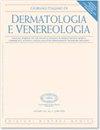男性尿道炎的临床特征和合并感染。
IF 2
Q3 Medicine
Giornale Italiano Di Dermatologia E Venereologia
Pub Date : 2021-01-01
DOI:10.23736/S0392-0488.20.06773-5
引用次数: 4
摘要
背景:在西欧,感染性尿道炎分为淋病奈瑟菌(NG)尿道炎和非淋球菌性尿道炎,通常由沙眼原体(CT)或生殖支原体(MG)引起。该研究的主要目的是评估临床特征与病原体之间的关系。其次,评估合并感染的流行程度。方法回顾性收集首次空尿核酸扩增试验(NAAT)证实的NG、CT和MG所致男性尿道炎的临床资料。临床资料包括排尿困难和/或分泌物的评估以及生殖器的临床皮肤镜检查。还进行了梅毒和艾滋病毒的血清学检测。结果101例NAAT确诊为NG、CT或MG型尿道炎。各病原菌感染率分别为50.60%、33.73%和15.66%。合并感染(4 MG+CT、1 NG+CT、1 NG+MG)病例较少,7-8%人支原体、虚幻美梭菌和细小美梭菌同时阳性。患者的中位年龄为33岁。88%的患者出现排尿困难(NG 95%, CT 79%, MG 78%)。86%的病例发现尿道分泌物,其中化脓性分泌物61% (98% NG, 70% MG),透明分泌物25% (64% CT)。95% NG、54% MG、29% CT有排尿困难、脓性排出,50% CT、23% MG、无排尿困难、透明排出(p<0.01)。balbalitis /meatitis的发生率为24%,生殖器疣的发生率为12%,直肠痛的发生率为4%。结论snaat对确定尿道炎病因有重要意义。排尿困难是最常见的症状。淋球菌性尿道炎表现为脓性分泌物,而透明分泌物与非淋球菌病原体有关。合并感染很少见。临床检查可发现其他传染病,特别是生殖器疣。本文章由计算机程序翻译,如有差异,请以英文原文为准。
Clinical profile and co-infections of urethritis in males.
BACKGROUND
Infectious urethritis are classified in N. gonorrhoeae (NG) urethritis and nongonococcal urethritis, caused commonly by C. trachomatis (CT) or M. genitalium (MG) in Western Europe. The primary objective of the study is to evaluate the association between the clinical profile and the pathogens. Secondly, to assess the prevalence of co-infections.
METHODS
The clinical profile of urethritis in men caused by NG, CT and MG confirmed by nucleic acid amplification test (NAAT) on first void urine has been retrospectively collected. The clinical profiles comprised the assessment of dysuria and/or discharge and the clinicaldermoscopic examination of the genitalia. Serological tests for syphilis and HIV were also performed.
RESULTS
A total of 101 episodes of NAAT confirmed NG, CT or MG urethritis were identified. The prevalence for each pathogen was 50.60%, 33.73% and 15.66%, respectively. Co-infections were observed in few cases (4 MG+CT, 1 NG+CT, 1 NG+MG), with M. hominis, U. urealitycum and U. parvum positivity found concomitantly in 7-8% cases. The median age of patients was 33 years. Dysuria was reported in 88% cases (95% NG, 79% CT, 78% MG urethritis). Urethral discharge was found in 86% of cases, including purulent discharge in 61% (98% NG, 70% MG) and transparent in 25% (64% CT). Dysuria and purulent discharge were observed in 95% NG, 54% MG and 29% CT cases, whereas dysuria and transparent discharge were observed in 50% CT, 23% MG and in none of NG cases (p<0.01). Balanitis/meatitis was observed in 24% of cases, genital warts in 12% and proctalgia in 4%.
CONCLUSIONS
NAAT is crucial for defining urethritis etiology. Dysuria is the most common symptom. Gonococcal urethritis present with purulent discharge, whereas transparent discharge is associated with non-gonococcal pathogens. Co-infections are rare. Clinical exam may detect other infectious diseases, in particular genital warts.
求助全文
通过发布文献求助,成功后即可免费获取论文全文。
去求助
来源期刊

Giornale Italiano Di Dermatologia E Venereologia
DERMATOLOGY-
CiteScore
1.90
自引率
0.00%
发文量
0
审稿时长
6-12 weeks
期刊介绍:
The journal Giornale Italiano di Dermatologia e Venereologia publishes scientific papers on dermatology and sexually transmitted diseases. Manuscripts may be submitted in the form of editorials, original articles, review articles, case reports, therapeutical notes, special articles and letters to the Editor.
Manuscripts are expected to comply with the instructions to authors which conform to the Uniform Requirements for Manuscripts Submitted to Biomedical Editors by the International Committee of Medical Journal Editors (www.icmje.org). Articles not conforming to international standards will not be considered for acceptance.
 求助内容:
求助内容: 应助结果提醒方式:
应助结果提醒方式:


